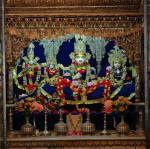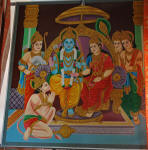Ayodhya, Uttar Pradesh, India
Ayodhya (also Oudh or Awadh), an ancient city, is one of the seven sacred cities of the Hindus. In the Ramayana, Lord Rama was born here during the reign of his father, Dasaratha, in a prosperous, well fortified city with a large population. In traditional history, it was the early capital of the kingdom of Kosala, while, in Buddha's time (6th-5th century BCE), Shravasti became the kingdom's chief city. Scholars equate Ayodhya with the city of Saketa, where the Buddha is said to have briefly lived. Its later importance as a Buddhist centre was attested by the Chinese Buddhist monk Fa-hsien in the 5th century CE who saw 100 monasteries here. Other monuments, including a stupa (shrine), were apparently built by Ashoka in the 3rd century BCE.
The Kanauj kingdom arose here in the 11-12th centuries. Later part of the Delhi sultanate, the Jaunpur kingdom, and the Mughal Empire, Oudh gained a degree of independence in early 18th century, before its subordination to the British East India Company in 1764 and annexation by the British in 1856; this and the subsequent loss of hereditary land revenue rights helped precipitate the Indian Mutiny of 1857. Despite the city's great age, few ancient monuments survive. Its temples and bathing ghats by the river Saryu are of no great age. Near the modern city are several mounds marking ancient settlements that archaeologists have not yet adequately explored.
Ayodhya's Babri Masjid was built in the early 16th century by the Mughal emperor Babur on a site believed by many to be Rama's birthplace, the Ram Janmabhoomi, and the location of an ancient Hindu temple, despite no conclusive evidence. Because of its significance to both Hindus and Muslims, the site was often a matter of contention. In 1990, riots in northern India followed the storming of the mosque by militant Hindus intent on erecting a temple on the site; the ensuing crisis brought down the Indian government. Two years later, on 6 Dec 1992, the three-story mosque was demolished in a few hours by a mob of Hindu fanatics. More than 1,000 people died in the rioting that swept through India following the mosque's destruction. [Adapted from Encyclopedia Britannica; March, 2006]
View from above  |
Main street  |
Main street  |
View from above  |
Kanak Bhavan (more)  |
Inner courtyard  |
Pilgrims (more)  |
Prayer hall (wall art)  |
Kanak Bhavan temple deity  |
Singing bhajans  |
"Danger-remover" Hanuman  |
Birla temple  |
Palace of Dashrath?  |
First courtyard  |
Second courtyard  |
Studious sadhu  |
|
Temple interior  |
Visitors with temple priest  |
 |
"Rangeen" Sadhu  |
|
Chatting sadhus  |
Smoking sadhus  |
Posing sadhus  |
Hallucinating sadhus  |
|
Temple in Ramkote citadel  |
Temple courtyard  |
Temple deity  |
Sadhu  |
|
Hanumangarhi area (more)  |
Stairway to Hanuman (more)  |
Inside the walls (more)  |
Hanuman temple (more)  |
|
Hanumangarhi visitors  |
Beggars lining the steps  |
Outside Ram Janambhoomi  |
Religious art in Saket hotel  |
One of scores of temples  |
Tulsidas park  |
Local tempo  |
Ayodhya train station  |
|
The Ghats on River Saryu |
|||
Ghat with railway bridge  |
Ghat with road bridge  |
Pilgrims at noon  |
Auspicious dip?  |
Ghat-side shrine  |
Saying a prayer  |
Whistling man?  |
Granny  |
|
Boatman  |
Holy dip?  |
Saying a prayer  |
Priestly type  |
Ghat scene  |
Changing clothes  |
Ghat scene  |
Ghat shelters  |
Listen to Baba Laldas, former priest at the Ram Janmabhoomi temple in Ayodhya, on the motivations behind the Ram temple movement and the people leading it. This is an excerpt from the documentary, Ram Ke Naam ('In the Name of God', 1992) by Anand Patwardhan, now on YouTube. Laldas spoke publicly against LK Advani's rath yatra (1990) and the demolition of the Babri masjid (1992). He was shot dead a year later and the murder case remains unsolved. |
|||
Designed in collaboration with Vitalect, Inc. All rights reserved. |








